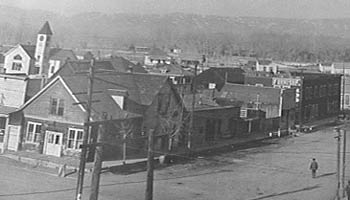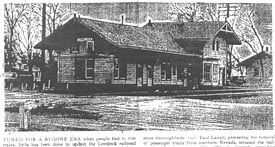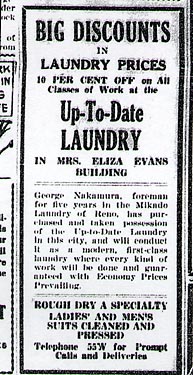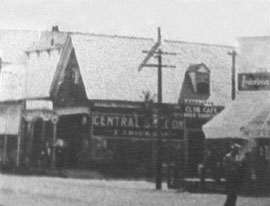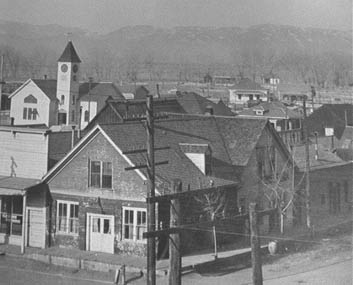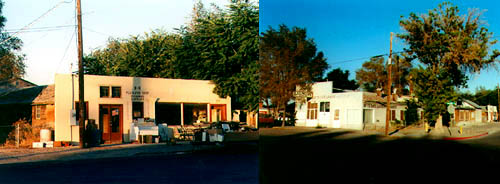
During the early and mid-1910’s, Louise continued to run her lodging house.
This could have been one of the major changes Robert made at the time the new dormers were added. Indoor plumbing and sewer lines were being built into more homes and businesses during the early 1900s in Lovelock. And electric light was finally replacing gaslight during the years of Louise and Robert’s marriage. The plumbing shop was still under Louise’s ownership, as her brother in law Lester Piper leased the business for a few years. It seemed to stay a plumbing shop through all its years, with Robert’s tools still in the shop. But I am still researching the history of the years during the late 1910's. Louise was in her fifties in the 1910's and her daughters were all grown and leading their own lives. Louise still had family in Lovelock, but like a family, Lovelock was changing too... |
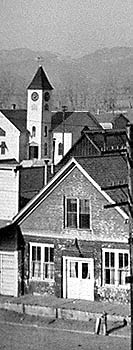 |
Lovelock Home The story of Edna Purviance’s Lovelock Home Research by Linda Wada © - October 21, 2004 Editing - Wes Wada Part Three - Changing Times The Later Years Edna left Lovelock in the summer of 1913. She enrolled in business school the fall of 1913 and found office work in the Bay area. In January 1915, Edna found herself part of the cast of Charlie Chaplin’s stock company at Essanay Studios, but that is another story. In the time between 1915 and 1923, Louise started spending more time away from her Lovelock home. With her daughter Myrtle living in San Francisco full time by late 1915, her daughter Bessie bouncing between California and Nevada, Edna in Los Angeles and relatives in Winnemucca, Louise had many chances to visit where she wanted and she did! |
| She was reported away often, especially later in the 1910’s. During these visits away, Louise would rent out her four-room home in the hotel. Eliza Evans appeared to become one of her renters in the late 1910’s. In fact, she appeared to be at Louise’s so much, that by 1920, Evan's name started to be associated with what was known as the Nurnberger Building. It could very well be that Eliza Evans was managing Louise's lodging house by 1920. And I found ads about a tailor and laundry shop in the Nurnberger building too. The shop most likely was in the old saloon space. After all the saloons closed in Lovelock during the Prohibition years, Louise leased the space out for other businesses. A paint and wallpaper shop appeared in early 1919, followed by a small laundry called 'Progressive Laundry and Tailor Shop'. This could have been Evan's business. But all during this time Lot 18 in City Block 14 was recorded in the tax records as a lodging house and plumbing shop. Only Lot 17 changed from saloon to laundry. Evans also appeared to have a laundry business in Frank Baker’s building on Lot 17. For a short time, even a small lodging house was mentioned in a drawing I found on the town, but there is no real evidence in the county records that it existed. It fact the building would not have been well suited for a lodging house. The only living quarters were located in the back and the rest of the building was an open floor plan. While this is still being researched, Evans attachment to Lots 17 and 18 certainly was in evidence by the early 1920’s. Evan's Corner replaced The Nurnberger Building and became the name used in newspaper articles and even in the early telephone book listings. I do not have early history on Eliza Evans, but the information I do have, appears she was an elderly widow, who had family ties in Winnemucca and elsewhere. She was fairly active in the social scene in Lovelock, as she was mentioned at functions in town. She was an active voter, as well. As Evans’ name appeared more connected to Louise’s property, Louise was most often reported leaving town for Los Angeles to Edna and San Francisco to be with her daughter Myrtle. Bessie Purviance Hill would join her mother too. (Bessie was still calling Lovelock home until well in the 1920's.) Louise would spend up to four months at a time visiting them. New decade, New Beginnings… Compared to the time when Louise first moved to Lovelock with her family in 1898, the 1920’s must have seemed like stepping out of a time machine. No longer were horses king, as autos ruled the roads. While trains were in use, the idea of airline flights was soon to be part of the future of travel. Stagecoaches were being replaced with motorized buses. And small hotels a short walk from the train depot were being replaced with modern spacious en suite rooms and motor lodges along newly created hard-paved highways. Even Lovelock, Nevada in Humboldt County changed to Lovelock, Nevada in Pershing County. And the streets Louise lived on changed names too! The corner Edna and Louise knew as 5th and West Railroad changed to 9th and West Broadway. And ‘C’ Street became Cordell. Living beside a railroad track was no longer the popular place to live. Cars created greater freedom to live and work further from the railroad lines along which towns like Lovelock were originally created.
Years of hard work and living in cold winter climates like, Silver City, Hailey, Paradise and Lovelock had finally caught up to her too. She suffered from bouts of rheumatism for most of her life, that only got worse with age. Living in a warm climate like southern California had to do wonders for her ailments. Edna could see the changes too and could have suggested that she move to Los Angeles to live with her. With Louise spending so much time in L.A., she finally made it official. She fully leased her property to Eliza Evans in 1923 and moved to Los Angeles. While she still owned her Lovelock home and business, I never found her mentioned as returning to Lovelock again. The year 1923 would also marked the end of Edna Purviance’s film career with Charlie Chaplin. Edna would do two more films, that had funding from the Chaplin Studios, but ‘A Woman of Paris’ was Edna’s last film under Chaplin’s direction. Edna's age, 28, and her presence at a tragic shooting scandal on New Years Day (the 1924 Dine Shooting), were just two factors that contributed to the end of her film career. (I will cover these events and 'A Woman of Paris' in the future on Edna’s site.) Louise’s move became permanent in 1931, as she sold her Lovelock home and business to Eliza Evans. Evans may have been in the process of buying Louise’s property since 1923, but the actual sale occurred in 1931. After Louise's marital experiences in Hailey, Idaho, Louise never totally let go of anything, until she was sure she had a secure home, and with Edna, she did. Edna was financially secure in part thanks to Chaplin’s generosity in keeping her on his payroll. In articles I have found, Chaplin was reported to feel deep anger about how people turned on Edna after the tragic events of the Dine shooting. Chaplin more than anyone truly valued everything Edna done for him. Keeping Edna on his payroll was a jesture of goodwill that helped Edna and her mother to have a decent life. During this same time in the early 1930’s, Edna Purviance slowly faded from memory both in the town where she grew up and on the silver screen that made her famous. She still had friends and family in the Lovelock area, but by the 1940’s, the fact that she lived in Lovelock and the location of her home were becoming obscure. By the 1950’s, new families were calling Lovelock home. While there were still people in town that knew Edna, they were getting fewer as the years passed. Edna apparently had few, if any friends left in Lovelock, as she would instead travel to Winnemucca to visit her family there. Edna died on January 13th, 1958. While I have combed the newspaper in Lovelock for the dates around her death, I have still have not found any mention of it in her own hometown paper in Lovelock. Winnemucca had the write up instead. As for Louise, she was mentioned in the Lovelock newspaper in 1950 after her death. She was remembered as a kind and generous soul who was always helping others. The same was said of her daughters. The Purviance and Nurnberger days were over, it was time for new dreams at the place they once called home. Lot 17 and the Later Years During the 1920’s Eliza Evans had become quite well known in Lovelock. The corner first known as the Grand Block in 1905, then the Nurnberger Building in the 1910's, became the Evans Corner. Evans seem to have a business connection to Lot 17, where a small laundry appeared to be in business again in the early 1920’s. The Lovelock French Laundry closed down about 1914. After the closing, the building was remodeled and opened as a saloon about 1915. But by 1918, all Lovelock saloons were closed down. The town was dry, but the tax records still listed Lot 17, owned by Frank E. Baker, as a saloon until 1924. But there is evidence that a laundry reopened in the building about 1920. Eliza Evans also appeared to be directly involved with the business.
As for Louise’s property it was still listed as a lodging house through the 1920’s and early 1930’s, according to the official tax records. Eliza Evans even had an ad for it in the Review-Miner in Lovelock and had a special dinner to invite guest and friends in town to her open house after taking over Louise's lodging business. Frank E. Baker still owned the building on Lot 17 where The Up To Date Laundry was located until his death in 1934. His wife, Ada Baker sold the building and lot to the lessees and owners of The Up To Date Laundry who were living in the building in 1934. The Up To Date Laundry remained a working laundry and cleaners in Lovelock into the 1990’s, operated by the same family until a death closed the business. But the long success of that business played an important role in the history of Edna’s old home. Meanwhile, at Lot 18 the lodging house Evans operated seemed to have a pretty successful run from the 1920's into the 1930's, despite the fact it was so out of date for the times. She did have room and board, and probably at a very affordable rate, compared to the new hotels in town. In comparison, the Big Meadow Hotel, just a block from Evan's lodging house, was newly rebuilt with en suite rooms in a modern two-story structure. The Big Meadow had been at the same location since the day the Purviances first stayed in it in November 1898, but the building itself had gone through many changes. Fires Cause Change Fire was one cause for buildings to update so often. Some businesses would burn not once, but sometimes up to three times in their history. Each time a more modern building would replace it. The Purviance property was very fortunate never to have been touched by fire during the years the family lived there. There was one time, during the time of Robert and Louise’s marriage, a fire did come close to burning their business, but it was small and was under control quickly. But fire would finally strike Edna’s old home, long after she left it. And I am told it happened in the second floor. I don’t have the exact date for I am still researching this, but I have an eyewitness account of a fire that started in the upstairs of the old lodging house. Next door, The Up To Date Laundry was in danger of burning; as the town’s people rushed to help the owners remove their items from the building. Luckily, the firemen did get the hotel fire out before too much damage occurred. One of the things that help save the Laundry is a little known fact about how these building were built. False fronts on these old western style buildings give the appearance of the buildings being connected. The Up to Date Laundry and the old Purviance’s lodging house were separated by a space of about four feet or so between each building. A closer look at the 1910 photo shows a door between the two buildings, as if connected, but if you were to walk inside that door, you would see nothing but the sky between both buildings. The door controlled access to the rear of the property. It was during the mid to late 1930’s that the lodging business that Louise spent years keeping up and Evans continued to run finally came to a close. The Paper Trail When I originally started looking for the history of the hotel, I started with the current owner and worked my way back. But in the early 1940 and mid 1930’s I lost the paper trail.
Evans failed to pay her taxes in the mid-1930s, so when a state official finally checked into the matter they found her in a poor state of health and not able to care for herself. A guardian was appointed to take care of her estate. Since the matter was not a normal procedure, the information was kept in a different section of the county records. After a couple of hours combing through original unrecorded documents I found the official court papers and the name of the guardian. Once I had the name of the guardian, I was once again able to find the property in the records. The guardian’s name was used in the sale of the Purviance’s old lodging property and plumbing shop. The property was sold in 1940 to George Lang. The Lang Family were friends of the Purviance family. I have found articles in the newspaper tying the Lang family to Bessie Purviance Hill, Louise Nurnberger and even Edna Purviance at special parties and dinners as early as the late 1910’s. Lang's Plumbing The Langs were well known and respected in Lovelock. The Lang Family arrived in the Lovelock area in 1907 where Mr. Lang was involved in mining. I found them involved with different city groups and serving jury duty. George Lang, Sr. had a son George Lang, Jr., which does add a bit of confusion keeping the two Georges separate over the years, because the papers were not always clear when talking about the George Jr. or George Sr.
Lang’s interest in the old hotel building may not been much, since there was no mention of any remodeling in that building, but his involvement in the plumbing shop was very strong. Lang owned the shop for about six years. In 1946, Lang sold the plumbing business to his son, John Lang and his friend Joe Patricio. John and Joe were both back from military duty and ready to start their new lives in Lovelock. Material for New Beginnings During World War II, lumber was in very short supply. Lumber was needed for the war effort, but the other reason for the shortage was the fact the young men who worked in the mills and in the forest were fighting in the war. With the lack of labor, lumber in towns like Lovelock became very scarce. The residents were resourceful. I have been told that some buildings in Lovelock today were once two-story buildings. If a roof needed repair on a two-story building, it was common to see the full second floor removed. Extra materials not needed for the repair were sold. Old buildings were also bought and moved to new locations. This was a time when many old mining towns were dismantled for building materials. After George Lang sold his business, John and Joe used these options to rebuild on the plumbing shop lot. According to a newspaper article in the Lovelock Review-Miner, December 12, 1946, John Lang and Joe Patricio bought an old county building once used by the CCC camp. As written in the Review-Miner, "Since the 80 foot structure was too long for their lot, they turned it into a L-shape at the rear and joined it onto the old building. They plan to convert the former shop into a display room for plumbing and electrical fixtures."  That old building was Robert Nurnberger's plumbing shop. In comparing the current building with 1910 photos of Robert's shop, the roof has been lowered and the basic structure changed, but the lot measurements show it at the same location. George Lang, Sr. built a very successful plumbing business at the location during the 1940’s, and his son John profited from the post-war boom when young men returned home to start new lives. The Up to Laundry enjoyed a steady business as well. Dry cleaning became popular, and there were also several Lovelock hotels and restaurants that needed linen service. Clean towels, sheets and cloth napkins were in demand. With the business prospering, more room was needed to park and load their delivery trucks. Before George Lang sold his plumbing shop to his son, he decided it was time to deal with the building on the surplus property next door. An end to an Era Edna’s old place belonged to the era of the stagecoach and steam train. In those days, living by the railroad was an asset, but that was no longer the case in the 1940’s. The Lovelock M.G. Purviance first observed in 1898 had given way to more modern times. In 1945, the old lodging building Edna Purviance had called home still stood on Lang's property. He knew it was the former Nurnberger home, since he knew the family. I have not found if any real repairs were made to the hotel after its second-floor fire, but its function as a lodging house was long gone. The rooms were small, out of date, with no in-room bathrooms. There was no parking for cars, now the main mode of transportation. Trains were still in use, but the heyday of the passenger train had passed. In checking the tax value of the hotel’s Lot 18, a big value drop occurred between 1946 and 1947. The lot which recorded a consistent value of $1600 for many years suddenly dropped to $300. This is strong evidence that the building had been demolished and removed. I was able to confirm this information through the property owner's descendents. They clearly remember the building, a relic and unsafe, and the fact it was torn down to make way for the new laundry expansion. The decendents recall the hotel's old days during Evans' ownership: people sitting outside enjoying the day and chatting to others. But they also remember how the building with all its small old rooms seemed a bit spooky. The person who tore down the building passed away in the 1960’s. The people I talked to remember the owners expanding their laundry, but they had no idea the property was once the home of silent film star Edna Purviance. Time to Move On When the Up to Date Laundry started in 1925, Eliza Evans was the woman most connected with Louise’s old lodging house. And it served its purpose through some of the toughest times of the depression. For Edna and her family, it also served as a livelihood for her mother and a stable place to call home. When three-year-old Edna first walked into The Singer Hotel building, it must have felt like a mansion with many rooms, sparkling new furnishings and the scent of fresh paint. But its rooms appeared cramped and creepy to a new generation who viewed the aging building. The layers of paint and wallpaper became chapters in time as the years rolled on. Each layer ‘witnessed’ a story, only later to be covered over with a fresh page.  As for The Up to Date Laundry, it is closed today, with its history locked inside. On the exterior weather worn ornate wood doors display the patina of its past. A closer look at the storefront windows show them to be exactly the same shape and style as the ones in the 1910 photo of the French Laundry. Except for the false front being altered, it looks to be the same building as the 1910 French Laundry. You can picture Edna in this building over the years, coming for a piece of candy from O’Leary's or dry goods from Baker's store, or to pick up a load of rough dried laundry. |
Back to Top
All other content Copyright 2003-2016 - Edna Purviance, ednapurviance.org Research Collection
Linda Wada, WadaWorks, All Rights Reserved
including photos and newspaper articles from public and private collections.
Special thanks to the official county offices and libraries from Humboldt and Perishing County.
